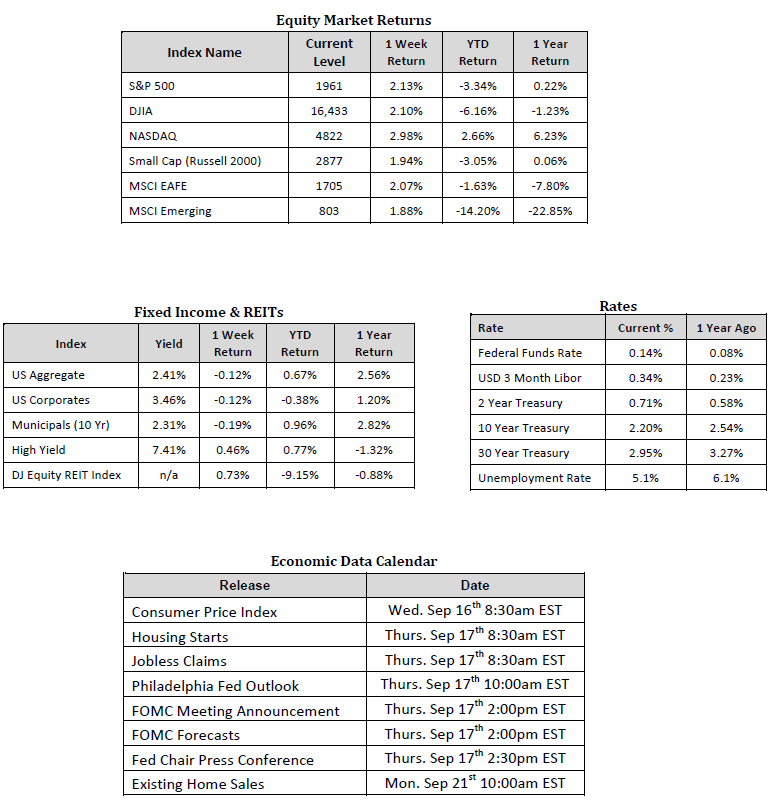
The Market, the Consumer, and the Month of September
Market Overview
Sources: Equity Market, Fixed Income and REIT returns from JP Morgan as of 9/11/15. Rates and Economic Calendar Data from Bloomberg as of 9/14/15.
Happening Now
Equity markets in the U.S. and around the world advanced last week as investors continued to digest the market gyrations of the past thirty trading days, when the volatility of the S&P 500 index more than doubled. Uncertainties surrounding the future path of Chinese economic and stock market growth as well as the Federal Reserve’s (“Fed”) upcoming decision on interest rates continue to stay at the forefront of traders’ minds and appear to be preventing conviction from taking hold. This is evidenced by the large daily swings in stock prices witnessed last Tuesday and Wednesday, when the S&P 500 index gained 2.5% to start the week (markets were closed Monday in observance of Labor Day), only to give back 1.4% the following day. Thursday and Friday’s sessions were quiet with daily moves on both days of about 50 basis points to the upside on relatively light volume.
The latest flash reading on consumer sentiment showed the markets recent drop has weighed on the minds of individual investors. The gauge fell to 85.7 from the prior measure of 91.9; lower than the consensus estimate of 91.0 and the lowest reading since September 2014 according to Bloomberg. This highlights the link between volatility in the stock market and the U.S. economy. Consumer spending currently makes up about 2/3 of the U.S. Gross Domestic Product and consumers, logically, tend to spend more when they are feeling better. Whether or not this actually translates into lower consumer spending is yet to be seen.
Consider September is a month that historically been a difficult month for investors. In fact, looking back to 1928, September has been the most difficult month, on average, for investors over the course of each year. The index, so far for the month is down just under 1% and it appears that we are setting up for continued intra- and inter-day volatility until more clarity on the two major uncertainties; the Fed and China, is found.
At SmartTrust®, we stress that investors with exposure to stocks consider asset classes that historically perform well during periods of volatility, as well as periods of rising interest rates, to better navigate today’s markets. While trying to time the market often serves as a drag on long term returns, adjusting the mix of asset classes to the correct dosage given the near term market environment can be a sound approach.
Given the wide swings in asset prices, it is likely the asset allocation strategy of your portfolio has changed.
Important Information and Disclaimers
Disclosures: Past performance does not guarantee future results. We have taken this information from sources that we believe to be reliable and accurate. Hennion and Walsh cannot guarantee the accuracy of said information and cannot be held liable.
Investing in foreign securities presents certain risks not associated with domestic investments, such as currency fluctuation, political and economic instability, and different accounting standards. This may result in greater share price volatility. These risks are heightened in emerging markets.
There are special risks associated with an investment in real estate, including credit risk, interest rate fluctuations and the impact of varied economic conditions. Distributions from REIT investments are taxed at the owner’s tax bracket.
The prices of small company and mid cap stocks are generally more volatile than large company stocks. They often involve higher risks because smaller companies may lack the management expertise, financial resources, product diversification and competitive strengths to endure adverse economic conditions.
Investing in commodities is not suitable for all investors. Exposure to the commodities markets may subject an investment to greater share price volatility than an investment in traditional equity or debt securities. Investments in commodities may be affected by changes in overall market movements, commodity index volatility, changes in interest rates or factors affecting a particular industry or commodity.
Products that invest in commodities may employ more complex strategies which may expose investors to additional risks.
Investing in fixed income securities involves certain risks such as market risk if sold prior to maturity and credit risk especially if investing in high yield bonds, which have lower ratings and are subject to greater volatility. All fixed income investments may be worth less than original cost upon redemption or maturity. Bond Prices fluctuate inversely to changes in interest rates. Therefore, a general rise in interest rates can result in the decline of the value of your investment.
Definitions
MSCI- EAFE: The Morgan Stanley Capital International Europe, Australasia and Far East Index, a free float-adjusted market capitalization index that is designed to measure developed-market equity performance, excluding the United States and Canada.
MSCI-Emerging Markets: The Morgan Stanley Capital International Emerging Market Index, is a free float-adjusted market capitalization index that is designed to measure the performance of global emerging markets of about 25 emerging economies.
Russell 3000: The Russell 3000 measures the performance of the 3000 largest US companies based on total market capitalization and represents about 98% of the investible US Equity market.
ML BOFA US Corp Mstr [Merill Lynch US Corporate Master]: The Merrill Lynch Corporate Master Market Index is a statistical composite tracking the performance of the entire US corporate bond market over time.
ML Muni Master [Merill Lynch US Corporate Master]: The Merrill Lynch Municipal Bond Master Index is a broad measure of the municipal fixed income market.
Investors cannot directly purchase any index.
LIBOR, London Interbank Offered Rate, is the rate of interest at which banks offer to lend money to one another in the wholesale money markets in London.
The Dow Jones Industrial Average is an unweighted index of 30 “blue-chip” industrial U.S. stocks.
The S&P Midcap 400 Index is a capitalization-weighted index measuring the performance of the mid-range sector of the U.S. stock market, and represents approximately 7% of the total market value of U.S. equities. Companies in the Index fall between S&P 500 Index and the S&P SmallCap 600 Index in size: between $1-4 billion.
DJ Equity REIT Index represents all publicly traded real estate investment trusts in the Dow Jones U.S. stock universe classified as Equity REITs according to the S&P Dow Jones Indices REIT Industry Classification Hierarchy. These companies are REITSs that primarily own and operate income-producing real estate.




